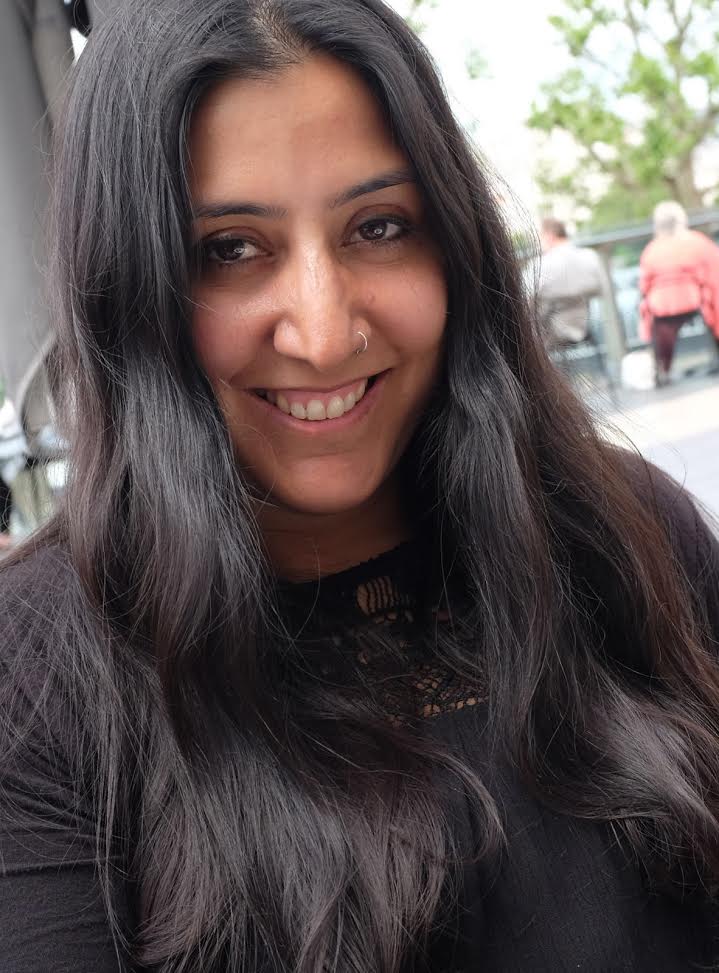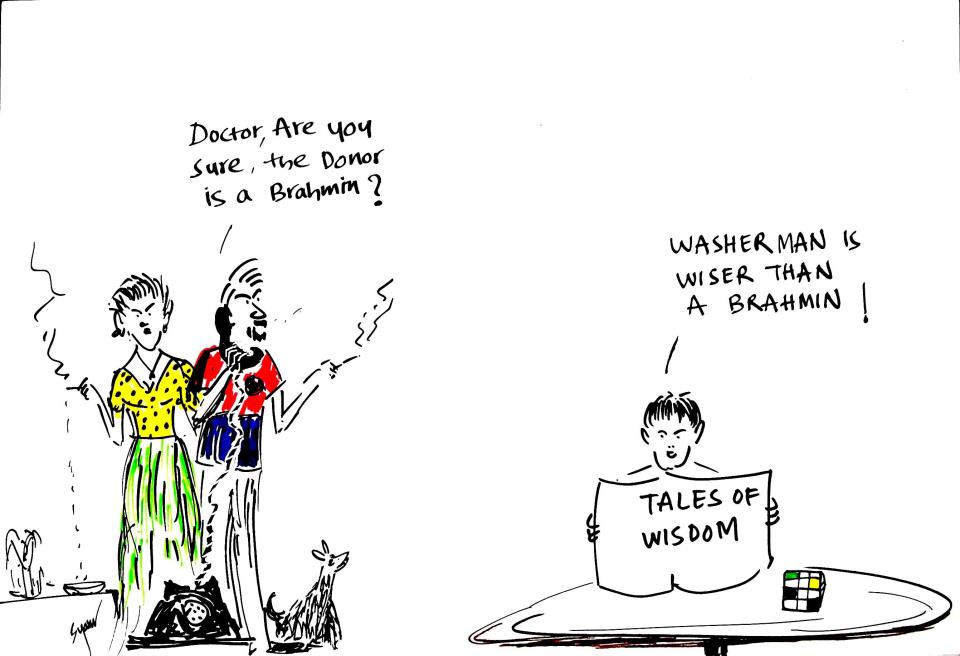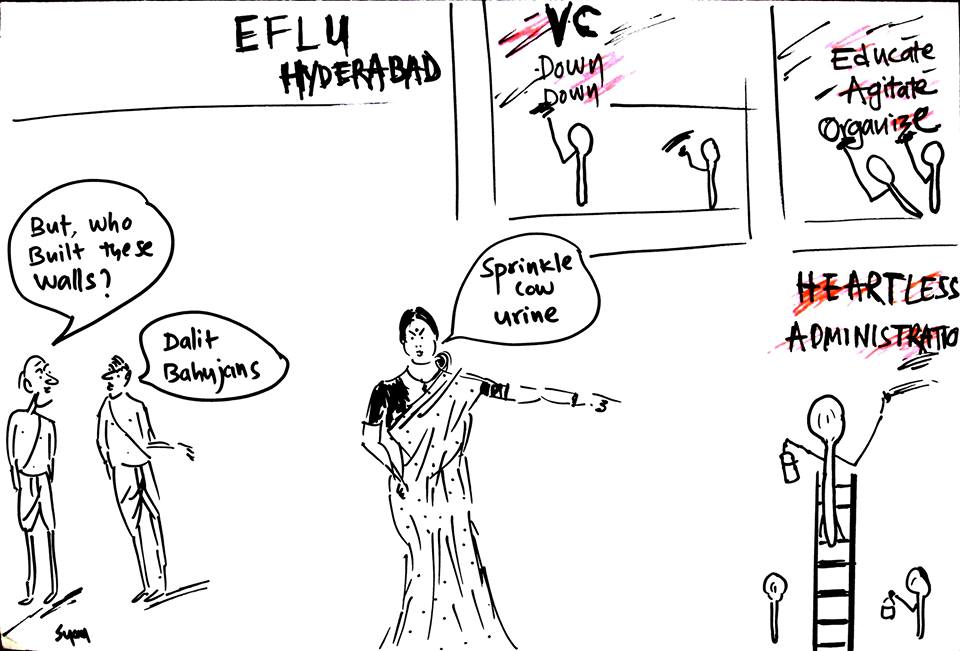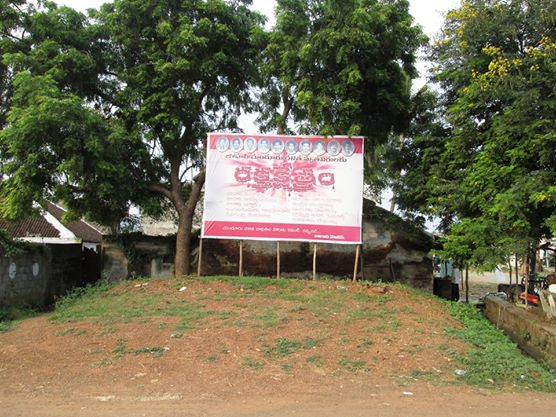Koonal Duggal and Kavita Bhanot

 A poster was recently shared widely on social media advertising a panel discussion at the 2017 Delhi Book Fair, titled ‘Contemporary Dalit Politics’.
A poster was recently shared widely on social media advertising a panel discussion at the 2017 Delhi Book Fair, titled ‘Contemporary Dalit Politics’.
The event was a discussion around Badri Narayan Tiwari’s new book Fractured Tales: Invisibles in Indian Democracy, which makes a case for the ways in which ‘dominant’, numerically larger dalit castes and the dalit movement, have failed to share resources and support the upliftment of more marginalized dalits. The three advertised speakers were the writer and academic Badri Narayan Tiwari, along with Shehla Rashid from AISA and Janhawi Ojha from ABVP.
~
The first poster released by OUP

Inevitably, there was comment and criticism on social media on the prospective discussion on dalit politics which did not include any dalit speakers. An online campaign began and letters were written to the CEO of Oxford University Press (OUP). Presumably in response to the criticism, two days before the event, a new poster was released with an addition to the panel: Milind Awad, assistant professor at JNU, and a ‘well known dalit activist.’

The second poster released two days before the event with inclusion of dalit academic and activist Milind Awad in the panel
We often hear the accusation that Ambedkarites do ‘identity’ politics. However, as we saw with this event, it is often from the place of power and dominance that the ‘other’ is reduced, as Rohith Vemula wrote so powerfully, “to his immediate identity and nearest possibility”. This is especially the case in ‘tokenistic’ politics, where the structures remain the same but a shallow deceptive inclusivity is performed. While Rashid and Ojha were identified, in the poster and in the session itself, in terms of their politics, through the universalized category of casteless ‘activists’, beyond identity – Awad was, on the poster, a ‘dalit activist’. As we attended the event, we found this tokenism apparent, not only in the new poster, but also in the event itself as it played out.
During the session Rashid and Ohja were also identified and highlighted in terms of their political position, most notably by Tiwari himself, as the last speaker. He had invited the two women to speak, he told the audience, out of curiosity as to how they would read and receive his book from their (apparently) opposite political positions in JNU. There was no acknowledgement of the fact that there were other political perspectives on the campus (BAPSA for example), or even on the panel. Meanwhile Awad also did not speak from or mention a political ideological location until the point at which the lack of this perspective was pointed out by some of us in the audience. It was at this point that the presenter of the discussion, a representative from OUP, virtually ran towards Awad, so Awad could announce, in an almost curtain lifting (back-covering) moment, that ‘as a dalit and Ambedkarite’ he supports Tiwari’s book.
In the current climate (a year on from Rohith Vemula’s institutional murder, a year into ongoing media highlighted student struggles), inviting these two JNU students of seemingly conflicting political positions seems to be little more than a sensationalist move on the part of the publisher. Particularly since both of these women activists seem to have little to do with dalit politics and, academically speaking, with the subject of discussion (the book ‘taught’ Ohja about caste). The intention is clearly to draw attention to the book release and therefore to sell copies of the book. However, the event is also another instance of the ways in which public ‘mainstream’ spaces remain entrenched in and perpetuate the left right binary and silence discourse that is outside of this, that is critical of both. The absence of the Ambedkarite perspective was particularly stark due to the subject under discussion. It was also another example of how all things under the category of ‘dalit’ are increasingly being sold, while keeping dalits and in particular Ambedkarites out of the conversation.
Meanwhile the discussion revealed the overlap, the mutuality of brahminical left and right positions – particularly in response to Ambedkarite critique. As we have also seen with the Jaipur Literature Festival this year, and its inclusion of RSS voices, it is with relative ease that left, liberal spaces – elite and cosmopolitan, including international collaborations, are being able to incorporate, in a strategic allying with the current government, right wing discourse in the name of inclusivity, freedom of speech even. This seems to reveal, all the more clearly, the compatibility of these brahminical positions. It is far more difficult to give space to Ambedkarite perspectives (beyond tokenistic ‘dalit’ voices) and voices which are uncomfortable for those who claim the ‘progressive’ space. We see these voices being silenced again and again in academic, literary, elite international spaces, where western frameworks adjust to local hierarchies, keeping the ‘cultural’ ‘local’ upper caste domination and discrimination intact – for example, in the blocking of Hatred in the Belly by Amazon Kindle in India. Those making decisions for Amazon Kindle India and the managing director in India of OUP display an upper caste brahminical mindset.
Both panelists who had been invited to speak as representatives of the left and right perspectives, were seen complementing each other despite their different political positions. They revealed the similarity between the two positions, especially in terms of their refusal to see caste in their daily life. Jahnawi Ohja, vice president of ABVP, declared that being from a science background, she knew little about caste (as if it is a subject of study) and had learnt a great deal from reading ‘Badri Bhaisaab’s’ book. Her entry point into the book and connection to it was perhaps the compatibility of its argument with the upper caste critique of reservation, as benefitting a ‘creamy layer’ of dalits; the oft heard complaint that reservation is useless, since privileged dalits are taking advantage of it. According to Ohja, the RSS, the ‘biggest NGO in the world’, which is ‘blind to caste’ has done more work for reform, for ‘harijans’, than any other organization. Indeed, according to Ohja, Ambedkar was a regular visitor of RSS run shakhas and supported its reform work towards harijans. This ahistorical statement from Ojha is an example that coincides with efforts by RSS to appropriate Dr. Ambedkar by creating a history that subverts his politics against brahminical Hinduism and its violence towards dalit bahujans.
For Rashid, a similar caste-blind transformative space was JNU, a place where she has felt liberated and free as a woman. Putting aside her lack of interrogation of the ways in which patriarchy plays out on the JNU campus, Rashid also displayed a reluctance to ‘see’ caste as it plays out in the university. While Ohja learnt about caste by reading Tiwari’s book, Rashid, who had not encountered caste much until she arrived at JNU, was enlightened, not through witnessing caste discrimination or even hearing the experiences of those who experience discrimination- but reading sociological studies on ‘caste in the village’. In this way, from both perspectives, there was a refusal to see caste discrimination in their daily lives.
Caste is located always, outside – outside urban spaces, outside the campus and its politics, outside themselves. The focus, in the discussion and in Tiwari’s book, is on dalits as a village/anthropological entity. Since last year however, Rashid has encountered caste through the institutional murder of Rohith Vemula – Rohith Vemula, as a singular instance, has come to represent caste beyond the village and beyond books. While, according to Ohja (her organization ABVP played a central role in Rohith Vemula’s murder), Rohith Vemula’s death was not an institutional murder but the suicide of a student (not of a dalit student), Rashid recounted going on Arnab Goswami’s show and insisting, contrary to Goswami and other guests on the TV panel, that Rohith Vemula was about caste.
We see, in Rashid’s referencing of Rohith Vemula, how after his death, he has become, along with Dr. Ambedkar, an almost symbolic figure for upper caste leftists, a tickbox reference, while they continue to be blind to continuing caste discrimination around them. While speaking of Rohith Vemula on the panel, Rashid said nothing about the current struggle for social justice currently taking place on the JNU campus, over a fee hike and the brahminical Viva Voce, and the suspension of nine Dalit, Adivasi, Bahujan, minority students. Indeed, while arguing in retrospect, that Rohith Vemula was about caste, Rashid has refused to acknowledge the role of caste in the suspension of these students.
Both the television interview, Rashid’s heroic recounting of it, and the book discussion panel itself are examples of how left liberal voices are able to claim for themselves in these spaces, the ‘radical’, alternative perspective – often appropriating, incorporating the least objectionable elements of Ambedkarite critique while actual Ambedkarite voices are invisiblised. So the debates and conversations that are had with Ambedkarites on campus, on social media, remain ‘private’ – but certain aspects of the discourse are transmitted as one’s own ‘radical’ ideas and positions. So, for example, echoing Ambedkarite assertion, Rashid also raised the continuity of pre and post independence discrimination of dalits in India. However, she, along with the left in JNU, has played a key role in silencing the same argument in reference to JNU, where parties such as BAPSA, questioning #we are JNU and JNU’s nationalism, have been arguing that their discrimination and struggle are longer term, not beginning with the BJP coming to power.
Through this invisiblising and silencing, or tokenism, Rashid, Ohja and Tiwari, across their political spectrums, were able to speak as figures of authority; representing a casteless universal perspective, able to speak for everyone. Referring to dalits as ‘them’, they othered and pathologised dalits, while performing a form of paternalism towards marginalized dalit ‘victims’ who have been ‘neglected’ by ‘dominant dalits’. Ambedkarite assertion challenges such upper caste paternalism, saviour narratives and ‘othering’ – of course there was no space for this in a panel so deeply entrenched in dominant upper caste structures.
Identifying the self as embodying a patronizing universal perspective is of course an aspect of brahminical supremacy, and Tiwari made this connection overtly and literally in a well-known 2014 interview, when he declared that “…..being a Dalit cannot be a precondition for writing about Dalits. One can also convert into a Dalit. Sometimes I was called a Dalit and I felt happy and I took it as a compliment. In short, it is possible for a writer to enter someone’s body, which I call parkaya pravesh.”1 In this way, making the writer and Brahmin synonymous, he claimed divine sanction for his right to speak for everyone.
Tiwari further justified himself, in the same interview and in the panel discussion, by declaring that although the work he has done in the book (researching and writing about the most marginalized dalits) was ideally the work of a dalit intellectual, due to the lack of emergence (presented as a failure) of such a dalit intellectual, the work had been left to him. This ‘failure’ of dalits and dalit movements, is central to the argument that Tiwari makes in his book and that was made in the discussion – the responsibility and failure of ‘creamy’ layer dalits, to ensure the rights of the most marginalized dalits. According to him, elite dalits have taken up all the space and resources: “The dominant dalit groups that now have control over the scarce resources should act as agencies to help distribute them to the poorest of the poor rather than gobble them up themselves,”2 he writes. These disturbing sentiments that lay the responsibility of the oppression of marginalized dalits, upon ‘dominant dalits’, are echoed throughout the book; “the bigger castes got the leverage of power…in this process democracy is actually going in the hands of those forces hurting democratic values by their dominance and creating hurdles in distribution of democratic resources among the most marginalised of the marginalised.”3 “The marginalised communities that have gained power do not want to share it with less fortunate brethren, thus creating a dominant community.”4 “…there is constant conflict among themselves for grabbing a larger share of benefits.”5 These are the devious ways in which brahminism is being perpetuated through Brahmin academia. What does Badri Narayan Tiwari reveal about himself when he uses such language, words such as ‘gobble’ and ‘grabbing’. How, as he was asked at the event, has he interrogated his own location and perspective in the writing of his book? Not to say that there are no power structures amongst dalits in the form of sub-castes and gender but, donning terms such as ‘dominant dalits’ and ‘dalit patriarchy’, brahminical knowledge production tends to focus on these, diverting attention away from the larger structure and the source of oppression (brahminism), and instead, generalizing about and pathologising oppressed communities, to play Brahmin savior. Such a diversion is founded in a fear of dalit assertion, wanting instead, to engage with dalits primarily as ‘victims’ and thus to retain power.
Meanwhile, there was no critical engagement with Tiwari’s book from any of the panelists at the event – such normalized epistemological violence cannot be acknowledged, or even ‘seen’ in such brahminical academic and literary spaces like this book release event by OUP. Instead, the entire discussion reduced dalit politics to the ‘politics of negotiation’ of power and benefits between dominant and marginalized dalits, leaving no space to articulate its radical potential as politics of assertion to dominant Brahminical hegemony. In this way, while seeming to address the question of dalit politics, as an ‘object’ of discussion, from left and right, from academic and activist perspectives, brahminical supremacy remained intact in the event. This is how academia and the publishing industries sustain each other and maintain existing structures/hegemony. A discussion on contemporary Dalit politics that leaves out Ambedkarite voices or one that includes dalit voices in a tokenistic way, is ultimately committed only to preserving the status quo, a status quo that can only be truly challenged through dalit, bahujan, adivasi, minority led spaces.
~
Notes
1. http://www.countercurrents.org/akumar131214.htm
2. Narayan, Tiwari (2016), Fractured Tales: Invisibles in Indian Democracy. Oxford University Press. p 26
3. Ibid: p25
4. Ibid: p19
5. Ibid: p14
~~~
Koonal Duggal is currently teaching at Department of Art History and Art Appreciation, Jamia Millia Islamia University. His research interests revolve around politics of caste, religion and visual culture.
Kavita Bhanot is a writer, teacher, editor, particularly interested in the politics of reading and writing.










